Wing Foil Surfing: Gear, Techniques, and Insights
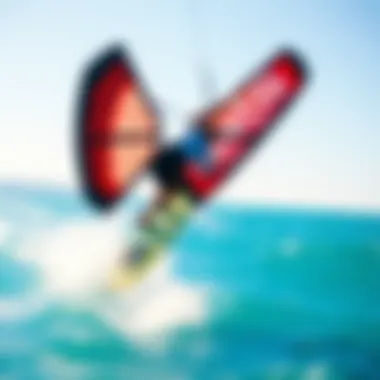
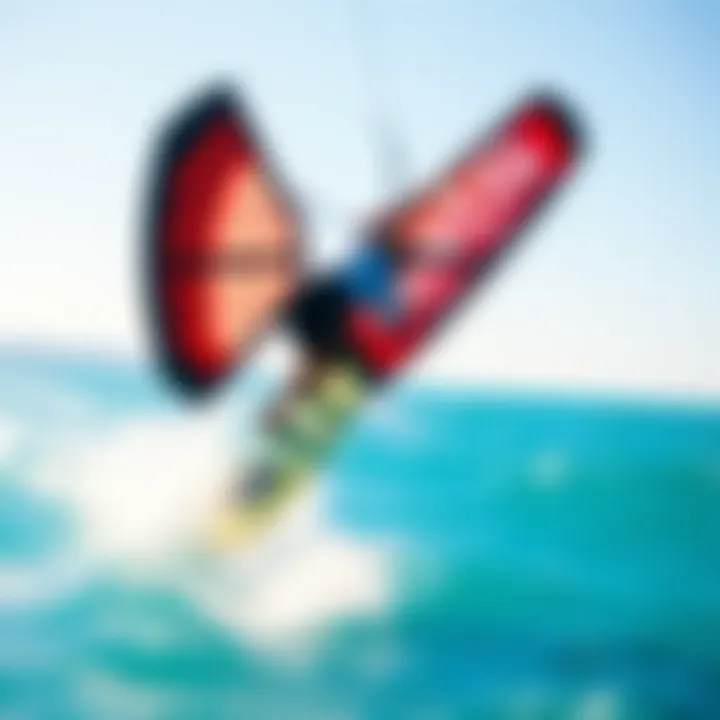
Intro
Wing foil surfing has emerged as a captivating blend of wind propulsion and aquatic maneuvering, exciting surfers and kiteboarders alike. It's a sport that offers an exhilarating rush without requiring expansive waves or pristine sailing conditions, making it accessible to various skill levels. With origins rooted in both surfing and kiteboarding, this unique sport has rapidly gained traction, drawing enthusiasts who crave the thrill of gliding smoothly over water while harnessing the wind's energy.
Understanding the key elements of wing foil surfing involves delving into essential gear and equipment, honing necessary techniques, and being mindful of safety as well as ecological considerations. This article aims to provide a thorough exploration of these aspects, enlightening readers about everything from the crucial equipment required to the awe-inspiring locations suited for this burgeoning sport. Whether you're a seasoned kiteboarder or a curious newcomer looking to dip your toes into the world of wing foiling, there’s something here for everyone.
Gear and Equipment
The foundation of any successful water sport, including wing foiling, lies in the gear and equipment. With the right tools, riders can unleash their potential and make the most out of their time on the water.
Essential Gear and Equipment for Beginners
To embark on your wing foil surfing journey, start by gathering the essential items:
- Wing: The centerpiece of wing foiling, wings come in various sizes depending on your skill level, weight, and wind conditions. A smaller wing is generally more maneuverable, while a larger wing provides better lift, translating to ease of use for novices.
- Board: Opt for a board specifically designed for wing foiling, typically wider and more buoyant than traditional surfboards to facilitate takeoff and stability while gliding.
- Foil: Invest in a good-quality foil system, which comprises a front wing, mast, and back wing. The choice of foil can significantly impact performance, so consider one that balances lift and stability, especially when you’re just starting.
- Safety Gear: Don't overlook a proper impact vest or a buoyancy aid. These not only provide comfort but are critical for safety.
- Leash: An essential component to keep your wing close, especially when you take a tumble. A good leash protects against losing your equipment during falls.
Advanced Equipment for Experienced Riders
As skills advance, so too does the desire for specialized equipment:
- High-Performance Wings: Experienced riders often favor wings with advanced design features allowing for increased speed and agility.
- Carbon Foils: These foils are lighter and stiffer, promising enhanced performance, especially for competitive riders.
- Custom Boards: Advanced board options include those with specific designs tailored for different conditions, enhancing performance even further.
- Wind-Specific Gear: Depending on local wind conditions, skilled riders may invest in equipment tailored for specific weather patterns to maximize enjoyment.
Techniques and Tips
Once you have the right gear, it’s time to look at the techniques that will elevate your wing foil surfing experience. Learning to maneuver efficiently and confidently on the board can take the thrill of the sport to a new level.
Basic Riding Techniques for Newbies
To get started:
- Positioning: Start with your feet placed firmly on the board, ideally shoulder-width apart. Keep your knees bent and your center of gravity low.
- Launching the Wing: Hold the wing above you with the leading edge tilted into the wind, slowly pulling it back to get some lift.
- Getting Up: As soon as you feel lift, make the transition from standing flat on the board to leaning forward. This allows the foil to generate lift, facilitating your rise above the water.
- Balancing: Focus on finding your balance on the board to steer using your body weight. It’s natural to have some wobbles at first, practice makes it smoother.
Expert Tricks to Elevate Your Skills
Once you feel confident, it’s time to spice things up:
- Carving Turns: By leaning into your turns, you can carve sharper and more defined paths across the water.
- Jumping and Tricks: Use the foil's lift to get airborne, attempting tricks like jumps or spins can spice up your riding experience.
- Wind Awareness: Developing an understanding of how wind patterns change can be invaluable, allowing you to capitalize on optimal conditions for performance.
Wing foiling is not just about surfing; it’s about redefining how we interact with water and wind alike.
Mastering the nuances of wing foil surfing requires patience and practice, but with the right gear, solid techniques, and a spirit of adventure, the rewards are boundless.
The journey of discovery in the world of wing foiling is as dynamic and exciting as the sport itself, creating a fusion of community, technique, and respect for our natural waters.
Foreword to Wing Foil Surfing
Wing foil surfing has become a thrilling darling among water sports in recent years. Combining elements of traditional surfing with the dynamic pull of wind, it creates an exhilarating experience for riders who seek both challenge and freedom on the water. The growing interest in this sport is not just a passing fad; it speaks to the human instinct for adventure and the joy of navigating unpredictable water and wind conditions.
As a newcomer or an experienced kiteboarder, understanding the intricacies of wing foil surfing becomes essential. It’s not simply about gliding on waves or harnessing the wind; there are technicalities and skills to master that elevate the experience altogether. Integrating key knowledge about equipment, body mechanics, and the environmental aspects can make one not just a participant, but a proficient rider who feels at home on the water.
Defining the Sport
At its core, wing foiling is the act of riding a board that is elevated above the water's surface by a hydrofoil, while wielding a wing or inflatable sail. This unique arrangement allows riders to skim over the water with a minimum of drag, giving them the impression of flying. Riders can choose to engage with the wind’s power in various ways: pivoting into the wind for more lift or riding with it for speed. The fusion of these elements introduces both a thrilling learning curve and a potential for endless joy, as each ride varies with the wind conditions.
"Wing foiling feels like dancing on water, every shift in the wind a new rhythm to embrace."
Some defining elements of wing foil surfing include:
- Foiling Mechanics: The hydrofoil consists of a mast, fuselage, front wing, and rear stabilizer, allowing for lift.
- Wind Control: Mastering the wing’s positioning changes how effectively you can harness the wind.
- Riding Experience: It stands apart from traditional surfing and kiteboarding because of its ability to glide effortlessly above the water.
Historical Background
Understanding the history of wing foil surfing is like peeling an onion; it reveals layers of evolution through other water sports. While the specific origins of wing foiling are harder to pin down, the sport borrows heavily from the practices of windsurfing and kiteboarding. The early 2000s saw the first prototypes of hydrofoils becoming popular in other realms of watersport. However, wing foiling gained traction as advancements in material science and design allowed for lighter, more efficient wings and foils.
The turning point came around the late 2010s when enthusiasts began combining elements of those earlier sports. This blend allowed the creation of specialized wings that were easier to handle and more accessible to novices. Additionally, social media played a crucial role in propelling wing foiling into the global spotlight; videos showcasing riders hovering gracefully over water captivated audiences worldwide.
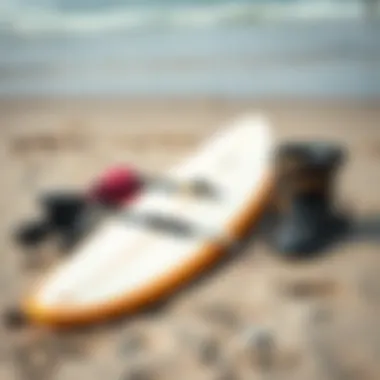
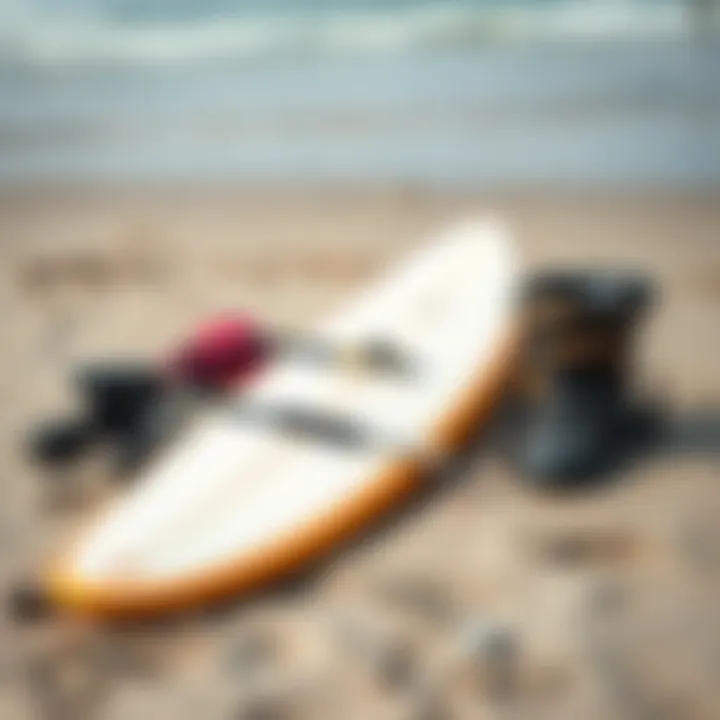
Thus, wing foil surfing stands not just as a sport, but as the convergence of innovation, nostalgia, and the relentless human desire to conquer the waves, revealing how far we’ve come in the evolution of water sports.
As participants today zip across ocean surfaces, it’s worth remembering the journey that brought wing foiling into the limelight and how this sport continues to evolve even now.
The Gear: Essentials for Wing Foil Surfing
When it comes to wing foil surfing, having the right gear is crucial. It’s not just about style; the equipment you're using can make or break your experience on the water. Every facet of the gear impacts how well you’ll maneuver and enjoy this captivating sport. Let’s walk through what you need to get started, understand the nuances of each component, and see why choosing the right gear is indispensable for both newbies and seasoned riders alike.
Wings: Types and Specifications
Wings are the heart of wing foil surfing. They harness the wind’s energy, propelling you across the water surface. There are various types of wings available, and understanding their specifications is essential for optimal performance.
- Surface Area: Generally, larger wings offer more lift, which is ideal for beginners or lighter riders. Smaller wings enable speed and agility, favored by advanced users.
- Aspect Ratio: High aspect ratio wings are long and narrow, ideal for faster speeds and efficient lift. Meanwhile, lower aspect ratio wings, which are wider, provide stability and are easier to control during transitions.
- Segmentation: Inflatable wings are popular due to their portability and ease of use. Hard wings, while less common, offer durability and can be better for jumping.
Whatever your choice might be, it’s important to pick a wing that suits your skill level and local wind conditions. Experimentation can lead to discovering your preferred set-up, so keeping an open mind goes a long way.
Foils: Understanding Lift and Control
When discussing the lift in wing foiling, foils take center stage. They're the underwater component that creates lift as you move. Here are a few factors that matter:
- Mast Length: This refers to how far below the water’s surface the foil extends. Longer masts allow for rides above choppier waters, providing a smoother experience. Yet, they require a higher skill level for balance.
- Wing Design: Similar to wings, foils come with various designs: you’ve got front wings for lift and stability, while tail wings serve to adjust performance characteristics. The combination of these shapes affects how you glide, maneuver, and perform tricks.
- Setup Flexibility: Some foils come with interchangeable wings, enabling you to adapt to different conditions by simply swapping attachments. This versatility is particularly beneficial for learning new tricks or adapting to changing wind patterns.
Understanding these aspects of foils means you can make informed choices, leading to safer and more thrilling rides.
Boards: Sizing and Styles
A suitable board complements the wings and foils perfectly, serving as your base on the water. The board affects your stability, speed, and overall comfort. Here’s what should be on your radar:
- Size and Volume: Typically, larger boards provide more stability, making them beginner-friendly. Smaller boards, conversely, are more nimble and allow for faster maneuvers. The volume of the board matters too; a higher volume often accommodates flotation for larger riders or those heavier on gear.
- Styles: There are predominantly two styles of boards—freeride and freestyle. Freeride boards are ideal for cruising while freestyle boards are designed for tricks and jumps, featuring a flatter contour for better pop.
- Construction Material: Boards made from composite materials tend to be lightweight and durable. The right choice can change your entire setup experience.
Ultimately, finding a board that matches your riding style will not only enhance your skills but will also make every session enjoyable.
"Having the right gear in wing foiling is not merely an accessory but a necessity to unlock the sport’s potential."
In summary, investing time and resources into selecting the right gear from wings to foils to boards significantly contributes to the success and enjoyment of wing foil surfing. Understanding the pivotal role of each component aids in navigating the waves effectively, maximizing your adventure while minimizing challenges.
Fundamentals of Wing Foil Techniques
Understanding the fundamentals of wing foil techniques is crucial for anyone wanting to dive into this exhilarating sport. Mastery of these techniques enhances not only the rider's performance but also their enjoyment on the water. Everything from balance to navigating wind becomes second nature with practice.
Getting Started: First Steps
When you're a beginner, the first step is getting a feel for the wing. Start on flat water, which allows you to focus less on the ocean conditions and more on handling your gear. Here are some key points to consider:
- Learn to Inflate the Wing Properly: A well-inflated wing responds quickly to the wind.
- Water Starts: Practice getting up on the board from the water. Use the wing to pull yourself up while keeping your weight centered.
- Body Positioning: Keep your knees bent and your weight distributed evenly on your feet. This helps in stabilizing your stance and maintaining control.
For many, the first attempt at getting up on the board can be daunting, but breaking the goal into smaller achievements builds confidence and skill.
Navigating: Wind Direction and Control
Once you're comfortable getting started, it’s time to focus on navigating. Wind direction plays a massive role in your ride. Learning to read the wind is akin to telling a story—the direction, intensity, and even gusts will dictate how your narrative unfolds.
- Recognizing Wind Indicators: Look for white caps on the water or observe how trees or flags behave in the breeze.
- Understand Your Wing’s Angle: The angle at which the wing meets the wind affects your lift and speed. Experimenting with different angles will help you find the sweet spot for control.
- Communicate with the Board: Your body should work in synergy with the board. Shift your weight according to the movements of the wind and water.
Riders who get to grips with wind direction quickly find themselves riding confidently, like a leaf carried effortlessly on a breeze.
Transitioning: Shifting Weight and Maintaining Balance
Transitions can make or break your ride. Mastering the fluid art of weight shifting while maintaining balance allows for smooth, uninterrupted navigation. As riders become more adept, these transitions turn into effortless maneuvers that enhance their enjoyment.
- Weight Distribution: As you prepare to move, think about where your weight needs to be—shift slightly forward when accelerating and back when slowing down or stopping.
- Turning Techniques: Learn to initiate turns by leaning slightly in the desired direction while steering the wing appropriately. A subtle shift can greatly affect your path.
- Practice Makes Perfect: Regular drills, such as deliberate transitions from heel to toe, can reinforce muscle memory, making these movements feel instinctive.
"Practice is not the thing you do once you're good. It's the thing you do that makes you good."
Ultimately, navigating through these foundational techniques opens up a plethora of opportunities for riders, paving the way for their personal style, performance, and enjoyment. Embracing each step with patience will lead to a fulfilling journey in the world of wing foiling.
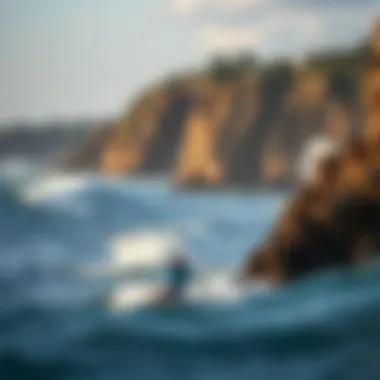
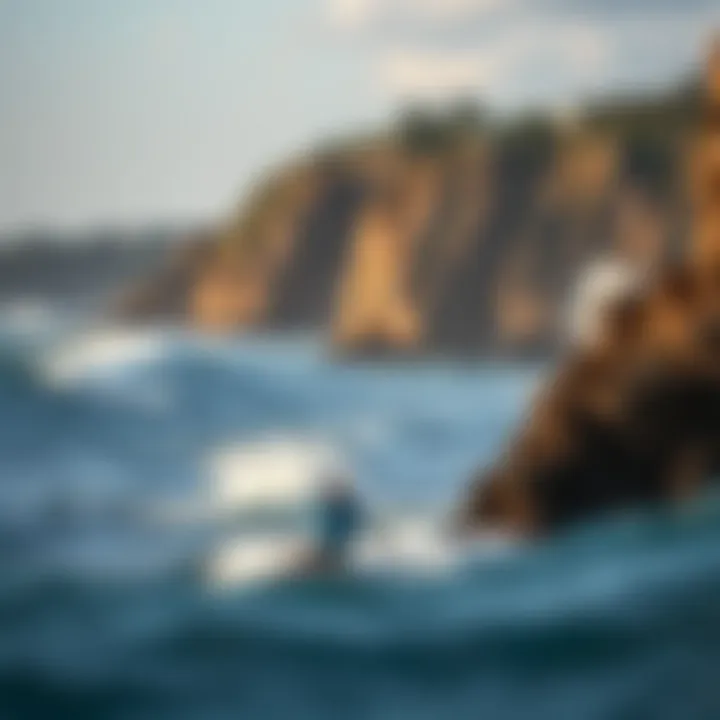
Safety in Wing Foil Surfing
When it comes to wing foil surfing, safety isn't just an afterthought; it's a cornerstone of the sport. The thrill of gliding over water, propelled by wind and lifted by a foil, can easily draw enthusiasts into the action. However, neglecting safety can lead to serious risks, both to the rider and the environment. As a sport that often takes place in unpredictable conditions, understanding safety protocols and embracing necessary precautions is essential for maximizing enjoyment while minimizing hazards.
Understanding the Risks
Every water sport has its dangers, and wing foiling is no exception. Some prominent risks to consider include:
- Variable Weather Conditions: Wind speed and direction can change rapidly. An unexpected gust or calm can impact control.
- Proximity to Watercraft: Many wingsurfers share the water with boats, jet skis, and other water sports enthusiasts. Collision is a serious concern if one isn’t aware of their surroundings.
- Equipment Failure: A tear in the wing or a malfunctioning foil can lead to accidents if riders are not prepared.
- Physical Strain: Like any sport, wing foiling can place strain on the body, especially if proper warm-up and technique are neglected.
By staying alert and informed about these factors, riders can significantly reduce their risk exposure.
Essential Safety Gear
Equipping oneself with the right gear can mean the difference between an unforgettable day on the water and a mishap. Essential safety gear includes:
- Personal Flotation Device (PFD): Wearing a PFD is a must. It helps keep you afloat should you find yourself in trouble.
- Helmet: A helmet can protect against head injuries, especially in crowded areas or when learning.
- Wetsuit or Rash Guard: Not only does this protect against chills, but it also guards against scrapes from the board.
- Leash: Keeping your wing attached to you can prevent losing it during a wipeout or rocky maneuvers.
- Whistle: A small but effective tool for signaling for help if you find yourself in a tough spot.
Prioritizing safety gear is as crucial as selecting the right wing and board for the perfect ride.
Safety Protocols and Best Practices
Adopting best practices is fundamental to ensuring a safe and enjoyable wing foiling experience. Here are some recommended protocols:
- Pre-Flight Checks: Always inspect your equipment for damage before hitting the water. Check the wing for tears and ensure the foil is securely attached.
- Know Your Environment: Familiarize yourself with local conditions, including tides, currents, and any potential hazards. Research a new spot before you launch.
- Buddy System: It's wiser to wing foil with a partner whenever possible. Keeping an eye on each other goes a long way in preventing accidents.
- Stay Hydrated and Rested: Physical endurance plays a key role in maintaining control and awareness. Never underestimate the importance of hydration and rest prior to going out.
- Wind Awareness: Understanding the wind’s behavior before starting can spell the difference between a great session and a risky one. Always be prepared for changes.
"Safety first isn't just a saying; it’s the essential truth of any adventure."
Riding the waves can be a beautiful experience when done safely. Being proactive about safety practices ensures that you can enjoy wing foiling—free to glide, turn, and explore the water with assurance.
Closure
In wing foiling, safety should stay front of mind. As you dive into the action, tying together awareness, proper gear, and good practices will help you navigate the exhilarating world of wing foiling while keeping risks at bay. With safety measures firmly in place, your focus can shift to mastering techniques and relishing the thrill of the ride.
Environmental Considerations
As more enthusiasts pick up wing foil surfing, understanding its environmental implications becomes increasingly important. This section will explore how water sports relate to our natural surroundings, potential impacts on ecosystems, and provide practical advice on sustainable practices for those partaking in this exhilarating activity.
The Impact of Water Sports on Ecosystems
Water sports, including wing foiling, sit at the intersection of thrill and environmental responsibility. While heaps of fun, these activities can leave a significant mark on delicate marine ecosystems. Water quality can suffer from the increased human interaction, and wildlife interruptions might occur as surfers skim across the surface.
When engaging in wing foiling, one must consider areas of high biodiversity, such as coral reefs or sensitive wetlands, where disturbances can lead to long-term damage. Protecting these vibrant ecosystems isn’t just good for the planet; it ensures that future generations can also savor the beauty of nature while wing foiling. Here are a few key points regarding their impact on ecosystems:
- Habitat Disruption: Noise from equipment and sudden movements can disturb marine species, particularly when they're nesting or feeding.
- Water Pollution: While most gear is environmentally friendly, spills from equipment maintenance or improper disposal of waste can cause significant harm.
- Overcrowding: Popular spots can become congested, leading to increased wear and tear on natural resources.
By being mindful, enthusiasts can mitigate their impact on ecosystems while still enjoying the sport outdoors.
Sustainable Practices for Enthusiasts
Embracing sustainability is essential for any wing foil surfer who wants to preserve the natural beauty of their favorite spots. Here are practical steps to engage in sustainable practices:
- Choose Eco-Friendly Gear: Opt for wings and boards made from recycled materials or environmentally-friendly processes, ensuring that your equipment is as harmless as possible.
- Stick to Designated Paths: Whenever possible, use marked areas to minimize the disturbance of ecosystems. Sticking to these routes helps prevent damage to wildlife habitats.
- Leave No Trace: After a session, always pick up any waste—yours and others—before leaving the area. Even things like straws or plastic wrappers can find their way into the ocean and cause great harm.
- Advocate for Clean-Up Initiatives: Join local clean-up efforts or start one in your community to raise awareness about the health of marine environments.
- Educate and Inspire: Share knowledge about ecological preservation within your wing foil community. The more people are aware of the issue, the better future conditions can become.
Sustainable practices not only help protect our waters but also enrich the experience for everyone involved. "We do not inherit the earth from our ancestors; we borrow it from our children." By applying these tips, wing foil surfers can enjoy a fantastic time on the water while honoring the environment.
For more information on the impact of water sports, you can refer to National Park Service and The Ocean Conservancy.
Destinations for Wing Foil Surfing
Wing foiling, a sport that pairs the grace of surfing with the thrill of wind power, thrives on the perfect spots where wind and water harmonize. Selecting the right destination is key to enhancing your experience, whether you are a novice eager to catch your first wave or an experienced rider chasing adrenaline. The right location can offer a combination of favorable winds, tranquil waters, and beautiful scenery, making all the difference.
Top Global Spots for Wing Foiling
Some locations are renowned for their exceptional conditions for wing foiling, and they cater to a variety of skill levels. Here are a few of the standout spots:


- Maui, Hawaii: Often regarded as the windsurfing capital of the world, Maui offers consistent trade winds and crystal-clear waters. Kanaha Beach is a popular spot, providing a range of conditions suitable for both beginners and seasoned riders. The natural beauty of the island adds to the experience, making every session feel like a mini-vacation.
- Tarifa, Spain: With its unique crosswinds and warm temperatures, Tarifa is a beacon for water sports enthusiasts. Known as the 'jewel of the Costa de la Luz', this town boasts a variety of beaches catering to different wind directions, allowing for year-round wing foiling.
- The Gorge, Oregon: The Columbia River Gorge is famous for its strong and consistent winds, ideal for wing foiling. The stunning landscapes and the vibrant community of water sports enthusiasts provide a unique atmosphere. Riders here often enjoy the thrilling gales and breathtaking vistas as they glide across the water.
"Finding the right spot for wing foiling is like hitting the jackpot. The winds, the waves, and the crowd all contribute to the experience you’ll remember."
- Cabarete, Dominican Republic: This Caribbean gem is known for its warm waters and strong winds, making it a favorite among travelers looking for adventure. Its vibrant local culture and community of water sport lovers add to the allure of wing foiling here.
These locations not only offer solid wind conditions but also the added benefits of local amenities, such as rentals, schools, and community hubs where enthusiasts can share tips and experiences.
Emerging Locations to Explore
As the sport continues to gain popularity, new destinations are cropping up around the globe that promise thrilling experiences for wing foiling. These emerging spots may not yet have the fame of their counterparts, but they offer unique charm and opportunities for discovery:
- Bonaire: This Dutch Caribbean island is gaining attention for its flat waters and reliable winds. It's an ideal spot for those looking to escape the crowded beaches while enjoying stunning marine life beneath the surface.
- Sardinia, Italy: Sardinia's diverse coastline, with its varying wind conditions and beautiful beaches, is starting to draw attention from the wing foiling community. The island presents a mix of flat water and waves, accommodating various riding styles and preferences.
- Cascais, Portugal: Known for its picturesque coastline and burgeoning water sports scene, Cascais offers strong winds and waves suitable for thrill-seekers. It's a spot on the rise, drawing both local and international kiteboarders seeking new adventures.
- El Médano, Tenerife: This location in the Canary Islands boasts ferrules of winds and one of the best climates in Europe. The diversity of the coastline means that you can enjoy wing foiling in various conditions.
Venturing to these emerging locations can lead to unique experiences away from the more crowded destinations while still enjoying the pure thrill of wing foiling.
Community and Culture of Wing Foil Surfing
Wing foil surfing isn’t just a sport; it’s a community, a gathering of like-minded souls who share a passion for the wind and water. When you’re out on the water, it’s not just about riding the waves. It’s about connecting with others, exchanging tips, and sharing the thrill of gliding over the surface. This culture is essential to the sport, fostering growth and encouraging newcomers to take the plunge.
Connecting with Other Enthusiasts
Making connections with fellow wing foilers is a crucial part of the journey. These relationships can range from casual acquaintances at the beach to lifelong friends who embark on adventures together. Many enthusiasts spend hours discussing gear, techniques, and local spots to catch the best wind. You can join local clubs or forums, both online and offline, to share experiences and learn from others who’ve been riding longer. Participating in community activities can make a huge difference, especially if you're a beginner feeling uncertain about your skills.
The online aspect is significant too. Platforms like Reddit or specific Facebook groups allow for sharing of experiences, asking questions, and getting advice. Like-minded individuals often organize meet-ups, swap gear, or plan trips to explore new locations. These gatherings can turn into events where everyone shares stories, best practices or even just laughs over their wipeouts. By networking with the wing foiling community, you not only improve your skills but also enrich your overall experience.
Events and Competitions
Events and competitions play a big role in shaping the culture around wing foil surfing. Not only do they showcase the incredible talents of riders, but they also create a sense of camaraderie among participants. Local contests can be found in many coastal areas, and they’re usually open to all skill levels. This inclusivity brings out the best in people, encouraging friendly competition and motivation to improve.
These events often feature workshops and clinics led by experienced riders. Attending such events can provide invaluable insights into advancing your techniques. You might discover the latest gear trends while soaking in tips from pros that you might not otherwise encounter. Moreover, these gatherings help draw in spectators who may not be familiar with wing foiling, spreading awareness and interest in the sport.
Future of Wing Foil Surfing
The trajectory of wing foil surfing is as dynamic as the wind that propels it. As this sport garners attention from a wider audience, it also fuels innovation and adaptation. Understanding the future of wing foil surfing is essential, not just for enthusiasts but also for stakeholders in the industry. This section shines a light on the advancements being pursued in technology and gear, which will enhance the experience. Additionally, the increasing popularity and community surrounding this sport speak volumes about its staying power.
Advancements in Technology and Gear
The realm of wing foil surfing is witnessing a wave of technological upgrades that promise to transform how enthusiasts engage with the sport. Manufacturers are constantly innovating, aiming to produce lighter, more durable wings and foils. For instance, wings made of advanced materials like ripstop nylon are taking over traditional fabrics due to their superior lightweight yet robust characteristics. These modern wings are designed with intricate airfoil shapes that enhance lift and maneuverability, making it much easier for riders to get up and foil with less effort.
The foils themselves have also evolved significantly. Nowadays, you can find an array of foil designs that cater to specific conditions and rider preferences. For example, those looking to surf smaller, choppier waves may prefer shorter and wider foils, while high-performance racers often opt for sleek, long foils that cut through the water with precision. Additionally, adjustable foil systems are becoming more common, allowing riders to customize their set-up based on the environment.
"Innovation is the key to sustaining any sport, and in wing foil surfing, we see the creativity of manufacturers resonating with the riders' ever-evolving demands."
Moreover, technological advancements extend beyond gear specifications. Smart tech is starting to enter the picture, providing data on performance metrics like speed, distance, and height gained. Devices that mount on the board offer real-time feedback, further assisting riders in honing their skills. Such tools not only amplify personal development but also create a shared community experience by allowing users to compare and analyze data with their peers.
The Growth of the Sport
The exponential growth of wing foil surfing is visible in countless conservations—from beach bonfires to online forums. It's not just a passing craze; people are catching on to the unique thrill that wing foiling delivers. With more schools offering lessons and rental services, diving into this sport is more accessible than ever. The growing base of participants naturally fosters a sense of community, where newcomers find support and mentorship from seasoned riders.
Social media platforms like Instagram and YouTube have further propelled this sport into the limelight. Enthusiasts share videos that showcase their adventures and tricks, inspiring others to hop on the bandwagon. These platforms while serving as significant marketing tools for brands, also create a robust community where tips, challenges, and experiences are exchanged.
As wing foiling continues to gain traction globally, more organized events and competitions are emerging. There is an exciting anticipation surrounding these competitions that further enhances camaraderie among participants. Local clubs and online leagues are sprouting up, providing riders of all skill levels a chance to compete and show off their abilities.
The surge in wing foiling interest is also tied to environmental consciousness. Many riders are becoming advocates for clean waterways and ocean conservation, emphasizing that the thrill of wing foiling should not come at the expense of nature.
As we gaze into the future, one thing is clear: the evolution of wing foiling is just beginning. With innovation at every corner and a passionate community behind it, this sport is positioning itself to leave a lasting impression on the world of water sports.
For more contextual insight into technological advancements and trends within the sport, resources like Wikipedia and forums on Reddit can provide valuable discussions.
Ending
As we wrap up this exploration of wing foil surfing, it's clear that this sport has a charm that draws in enthusiasts from all walks of life. The lasting appeal of wing foiling lies not just in the adrenaline rush of gliding over water, but in the community it fosters and the adventure it promises. With every surge of wind and wave, riders are not just catching a thrill; they are becoming part of a growing culture that values connection with nature and each other.
The Lasting Appeal of Wing Foil Surfing
The essence of wing foil surfing can be summed up in its unique blend of freedom and challenge. It's as if the ocean cradles you while the wind urges you forward, an intoxicating experience for those who relish outdoor activities. Here are a few key aspects that highlight its enduring allure:
- Versatility: Wing foiling is adaptable to various conditions, from calm lakes to lively ocean swells. This diversity enables riders to explore different terrains, making it an exciting sport for adventurers.
- Accessibility: Unlike traditional surfing, which may demand expensive waves and specific conditions, wing foiling opens a realm of options. Beginner-friendly spots are numerous, allowing novices to dive in without overwhelming pressure.
- Physical Benefits: The sport engages multiple muscle groups, fostering balance, strength, and coordination. Over time, riders often notice enhanced fitness levels, which is particularly appealing for health-conscious individuals.
- Mind and Soul Connection: There's something undeniably meditative about being on the water, propelled by the wind. It encourages mindfulness and a reconnection with nature, offering an escape from urban life.
"The ocean stirs the heart, inspires the imagination, and brings eternal joy to the soul." – Wyland
The future is brimming with potential for wing foil surfing. As technology advances and the community grows, so does the knowledge base surrounding this sport. From new gear to improved techniques, the possibilities are endless. Whether you’re just starting or a seasoned rider, there’s always something new to discover.















